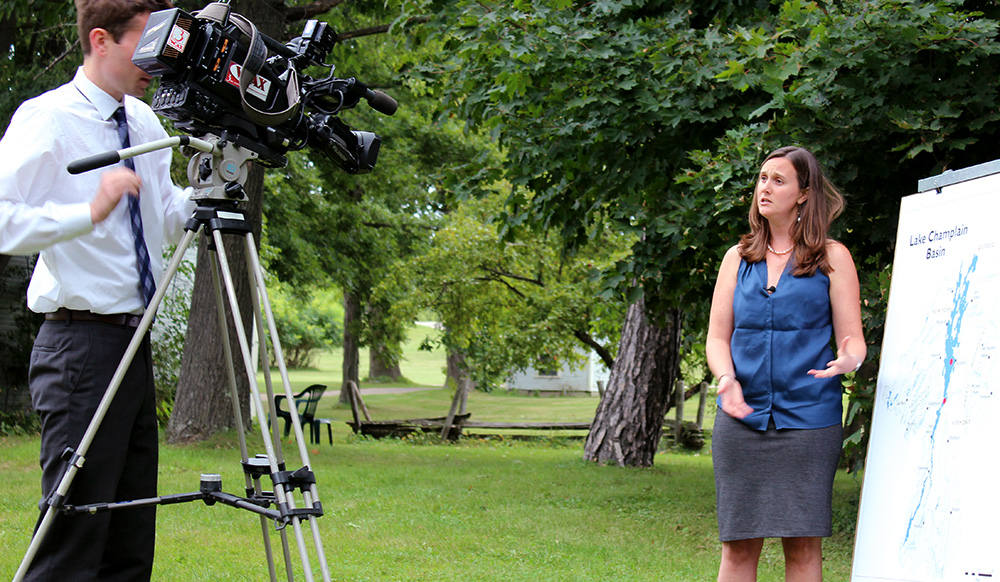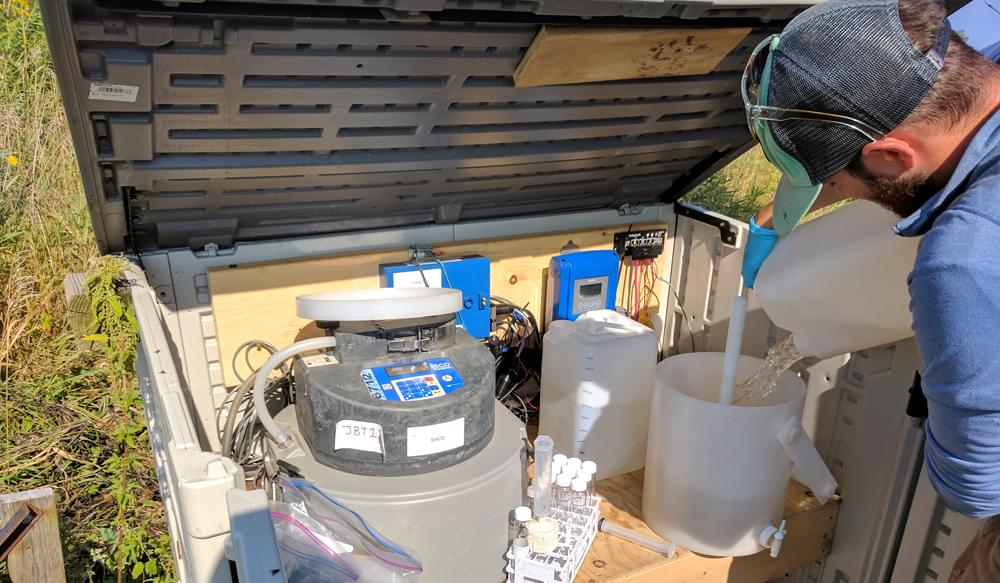
Press Center
Tools and Resources for Media Professionals
The Lake Champlain Basin Program (LCBP) coordinates and funds efforts to benefit the Lake Champlain Basin’s water quality, fisheries, wetlands, wildlife, recreation, and cultural resources, in partnership with government agencies from New York, Vermont, and Québec, private organizations, local communities, and individuals.
The Lake Champlain management plan Opportunities for Action identifies four goals that address the key resource issues facing Lake Champlain and its watershed—clean water, healthy ecosystems, thriving communities, and an informed and involved public. These goals serve as the framework for much of the LCBP’s work.
The LCBP publishes a report of activities each year to provide a detailed accounting of the grants and technical projects managed by the Program and staff-driven projects and activities. Every three years, the LCBP publishes the State of the Lake and Ecosystem Indicators Report to inform citizens and resource managers about the health of the Lake.
General Media Inquiries
Colleen Hickey
Education and Outreach Coordinator
chickey@lcbp.org
(802) 372-0211
Photo and Video Requests
Ryan Mitchell
Communications and Publications Coordinator
rmitchell@lcbp.org
(802) 372-0212
STORY LEADS
This list includes current or recently concluded work conducted or supported by the LCBP.
The LCBP released the 2024 State of the Lake and Ecosystem Indicators Report on June 5, 2024. Drawing on the most recent scientific data, the report provides a comprehensive assessment of the condition of Lake Champlain. The report documents ongoing challenges and recent successes in management of the Lake’s water quality and ecosystem.
Read the press release →
Key messages from the 2024 report include:
Clean Water
- Approximately 164,000 people, or about one quarter of the Basin’s population, get their drinking water from Lake Champlain. Public drinking water suppliers on Lake Champlain are required to monitor for over 80 potential contaminants in drinking water to protect public health. Water from Lake Champlain rarely exceeds limits for any of these contaminants.
- Data show continued reduction in mercury levels in Lake Champlain fish. However, people who choose to enjoy Lake Champlain fish as part of their diet should be aware of fish consumption guidelines developed for New York, Vermont, and Québec, which determine safe fish consumption levels.
- During the Memorial Day to Labor Day periods since 2021, public beaches were open about 95% percent of the time. Cyanobacteria blooms caused closures about 4% of the days during this timeframe, and high counts of coliform bacteria caused closures less than 2% of the days. Several beaches had very few or no closures since 2021; St. Albans Bay Park was most affected and was open about 87% of the time between Memorial Day and Labor Day.
- Since 2013, 94% of routine visual assessments on Lake Champlain during the recreational season reported conditions free of cyanobacteria blooms. These reports differ among regions of Lake Champlain. Cyanobacteria blooms in Lake Champlain’s Main Lake region are relatively infrequent, while cyanobacteria blooms are more common in St Albans Bay and Missisquoi Bay.
- Cyanobacteria blooms can sometimes produce toxins – known as cyanotoxins – that can be harmful if ingested by humans, pets, or wildlife. Although these toxins are rarely detected in Lake Champlain, it is best to avoid areas with active cyanobacteria blooms.
- Phosphorus is a key nutrient that drives cyanobacteria blooms. Overall, phosphorus levels must be reduced to consistently meet water quality goals. Lake Champlain has targeted phosphorus limits for each of its 13 segments – these were established in 1991 to protect important uses, including swimming, recreation, aesthetics, water supply, and ecosystem health. Since monitoring began in 1990, none of the Lake’s segments have maintained annual phosphorus levels consistently below these limits.
- The 13 Lake Champlain segments vary in how their phosphorus levels compare to targeted limits each year. For most years since 1990, annual phosphorus levels in Burlington Bay and Cumberland Bay were below their limits. For 40–50% of the years during the same time frame, annual phosphorus levels were below limits in Isle La Motte, Shelburne Bay, and the Southern part of the South Lake. In contrast, Missisquoi Bay, St. Albans Bay, and the northern part of the South Lake continue to face significant challenges, as their annual phosphorus levels have consistently exceeded targeted limits since monitoring began.
- Some areas of Lake Champlain with higher phosphorus levels are impacted by “legacy phosphorus,” which is phosphorus deposited in the past from human activities in the watershed and stored in lake bottom sediments.
- The annual phosphorus loading from the past decade has been significantly lower in seven of our major tributaries. This story is more mixed for the Missisquoi River and Winooski River: although the past decade has seen relatively higher phosphorus loading in the Missisquoi and Winooski Rivers compared to previous years, the latest data shows significantly lower phosphorus loads in these rivers in the past three years. Our data shows that phosphorus loading to Missisquoi Bay was low enough in 2021 to meet its annual target for the first time since monitoring began.
- In the 7-day period beginning with the July 2023 storm, about 300 billion gallons of water and more than 300 metric tons of phosphorus were likely delivered to Lake Champlain, totaling roughly half of the annual targeted phosphorus load. Although the Lake did not exceed flood stage in the past three years, the 2023 storms led to unseasonably high lake levels and caused 24 highest-ever-for-the-date records for Lake Champlain in 2023.
Healthy Ecosystems
- Lake Champlain is home to over 90 species of fish including sport fish such as bass, perch, walleye, lake trout, and landlocked Atlantic salmon. Monitoring by Vermont and New York fish and wildlife departments shows an increasing trend in bass size and catch rate.
- Natural-born lake trout are making a comeback in Lake Champlain. Due to the increasing number of wild-born fish found in surveys, fisheries managers reduced stocking in 2023 by half. Lake trout may be on track for a full recovery with a self-sustaining population in the near future.
- Sea lamprey are parasitic eel-like fish that feed on Atlantic salmon, lake trout, and other sport fish in Lake Champlain. Due to effective management actions, sea lamprey wounding rates on lake trout and Atlantic salmon are the lowest in management history.
- This 2024 report includes a new section focused on aquatic organism passage and habitat connectivity. Under-road culverts and dams can be full or partial barriers for fish, insects, and other aquatic life, cutting off their access to critical habitat up or downstream while also increasing flooding and erosion. Just 6% of over 8,000 surveyed under-road stream culverts provide full passage to aquatic organisms.
- Restoration work is helping Atlantic salmon gain access to their historic river habitat. Last year, the remnants of Indian Rapids and Fredenburgh Falls dams on the Saranac River were removed, laying the groundwork for salmon to access most of their historic Saranac River range by 2026, when construction of a fish ladder at Imperial Mills Dam is planned. Once complete, over 13 miles of spawning habitat on the Saranac’s main stem and another 18 miles on tributaries will be available to salmon for the first time in over 250 years.
- There have been no new detections of invasive species—non-native plants, animals, and pathogens that cause harm to the economy, environment, or human health— in Lake Champlain since the introduction of the fishhook waterflea in 2018.
- The lack of new introductions is no accident. Boat Launch Stewards provide free voluntary inspections of boats and equipment to prevent the spread of aquatic invasives to and from Lake Champlain.
- The round goby fish, the quagga freshwater mussel, and hydrilla aquatic plant are among the greatest invasive species threats to the Lake Champlain Ecosystem. To help stop the spread of aquatic invasive species, please be sure to Clean, Drain, and Dry all boats and equipment before moving to a different lake or river location.
- The Champlain and Chambly Canals connect Lake Champlain South to the Hudson River and Great Lakes and North through the Richelieu River to the St. Lawrence Seaway. These human-made systems provide a potential pathway for invasive species to spread to our lake.
- The densest populations of invasive water chestnut have been pushed south from Crown Point down to the Dresden Narrows over the past 25 years through mechanical harvesting efforts. Hand-harvesting management of known geographically isolated infestations in Missisquoi National Wildlife Refuge, Black Creek Marsh, and Sandbar State Park have been reduced. Unfortunately, new populations of water chestnut have been discovered in Dead Creek near Plattsburgh, in Gander Bay just outside the Missisquoi National Wildlife Refuge, and in the Sandbar Wildlife Management Area.
- In the early 1900s, the entire surface of Lake Champlain froze nearly every year. It now completely freezes much less frequently—currently once about every five years. If this trend continues, by 2050 the Lake surface may completely freeze just once per decade.
Informed and Involved Public
- A public awareness survey conducted in 2021 by Lake Champlain Sea Grant, University of Vermont Extension, and the Lake Champlain Committee found that 65% of people strongly agree that their personal actions affect the health of water bodies, but only 25% are aware of actions they can take or where to learn more. Only 10% took more than half of six select stewardship actions.
- The survey found that residents and visitors to the Lake Champlain Basin learn about water quality and ecosystem issues through a variety of sources. The LCBP and partners are working to reach audiences through new and traditional outlets.
- The survey showed a significant percentage of people still prefer to receive information from traditional media such as television news and newspapers. The LCBP and Lake Champlain Sea Grant are working to enhance relationships and coverage with traditional news media in the region. The University of Vermont has also started fostering the next generation of environmental reporters when its Community News Service launched “Stories of the Lake,” a program in which students wrote stories for local news outlets.
- The LCBP Resource Room at ECHO, Leahy Center for Lake Champlain welcomed its half-millionth visitor in March 2023 and went on to record its busiest year ever by welcoming more than 34,000 visitors in 2023.
- Boat launch stewards on Lake Champlain engaged with 152,703 individuals between 2021 and 2023. 13% of watercraft inspected were carrying aquatic hitchhikers. They intercepted 4,669 aquatic invasive species on boats being taken out of Lake Champlain, preventing spread to other water bodies that are free of AIS. They also intercepted 793 species on boats being launched the Lake, including hydrilla, quagga mussel and more. The boat launch steward program is a regional partnership with Adirondack Watershed Institute and OBVBM, which helps to assume coordination and consistency in methods and in tracking and preventing the spread of AIS.
- Learning opportunities for students have grown with new and expanded education programming. Lake Champlain Sea Grant’s watershed alliance expanded to New York, significantly increasing the reach of classroom and field-based watershed education work. Through the Champlain Basin Education Initiative partnership, 200 students participated in the inaugural Clean Water Youth Summit in May 2023, where they explored clean water activities on the Burlington waterfront and paddled, sailed, fished, or rowed on the Lake.
- Participants in several new programs, including the LCBP’s Artist-in-Residence program, interpret data and historical records using creative media such as wool, ceramics, paper and light, oil and canvas, film, and music to communicate watershed information to the public.
- Research shows that prompting individuals to act often requires enhancing education and outreach efforts with targeted campaigns addressing specific motivations and barriers to action. Several new and ongoing social marketing programs are doing this.
- In response to recommendations included in the public awareness survey report, the Lake Champlain Committee and Lawn to Lake partners are reinvigorating the Don’t “P” on Your Lawn campaign, which encourages people to not use phosphorus (P) fertilizers.
- The Raise the Blade campaign, which encourages people to increase the cutting height of their lawnmowers and allow their grass to grow taller, improves soil health and reduces runoff. More than two dozen businesses and many more homeowners have committed to “raising the blade” since 2019.
- In 2021, the Stream Wise initiative was launched in New York, Quebec , and Vermont to recognize private landowners who foster stream health and flood resilience by maintaining buffers of native plants along the sections of the rivers and streams they own. Since its inception, Stream Wise partners have assessed 98 properties, 55 of which have earned Stream Wise awards.
- To counter increasing chloride concentrations in New York waterbodies, AdkAction launched the Clean Water, Safe Roads public outreach campaign in 2023. This campaign asks participants to pledge to reduce their use of deicing salts and encourage others to do the same to reduce the impact of salts to aquatic ecosystems, drinking water, and infrastructure.
Thriving Communities
- Respondents to a 2021 public awareness survey cited a healthy environment, clean drinking and swimming water, and recreation as the top reasons why clean water is important. Ninety-six percent of respondents agreed that healthy waterways are a critical part of thriving communities, and 96% felt that addressing water quality should be a priority for communities. While there is broad consensus on the importance of clean water, only about half of the respondents were aware of efforts in their communities to improve water quality. About 65% knew how to find information about protecting water quality.
- While the numbers around engagement show room for improvement, many community members are engaged in programs sponsored by partners of the Champlain Valley National Heritage Partnership. More than 17,000 people attended 265 programs and events from 2021 through 2023. More than 600 people worked more than 9,400 hours on projects to protect cultural and recreational resources, providing $303,275 worth of their time.
- New programs that provide free or reduced-cost access to recreation and cultural resources are fostering greater understanding and stewardship of these resources. In 2021, the Lake Champlain Maritime Museum eliminated admission fees and saw a 30% increase in visitors. Nearly one out of five visitors said they specifically came because the museum was free, and two out of three were first-time visitors. The Community Sailing Center is increasing diversity among stewards of the Lake by offering free Floating Classroom programs for students in underserved communities. Participants learn sailing and water safety skills along with the importance of clean water and the impact of individual choices.
- Multilingual outreach and messaging are helping to better inform members of diverse communities about fishing regulations, water quality, and human health. Since 2021, more than 300 members of new American and economically disadvantaged communities have participated in fishing education workshops, which were started at the request of community leaders to help reduce the number of people who receive citations for violating local fishing regulations, including fishing without a license.
- The public awareness survey found that only 18% of the public had attended a meeting about water quality in the preceding three years. The LCBP has reinvigorated Citizens Advisory Committees in Vermont, New York, and Québec since 2021. More than 50 public meetings have been held. The meetings provide opportunities for the public to be involved in developing management priorities that are shared with the Lake Champlain Steering Committee and lake managers.
RESOURCES
The Lake Champlain Basin Program coordinates and funds efforts that benefit the Lake Champlain Basin’s water quality, fisheries, wetlands, wildlife, recreation, and cultural resources. The program works in partnership with federal agencies, state and provincial agencies from New York, Vermont, and Québec, local communities, businesses, and citizen groups. NEIWPCC—a regional commission that helps the states of the Northeast preserve and advance water quality—serves as the primary program administrator of LCBP at the request of the Lake Champlain Steering Committee and administers the program’s personnel, finances, and contracts. NEIWPCC is a program partner of LCBP. For further information, contact the Lake Champlain Basin Program, 54 West Shore Road, Grand Isle, VT at (802) 372-3213 / (800) 468-5227 or visit https://www.lcbp.org/.





